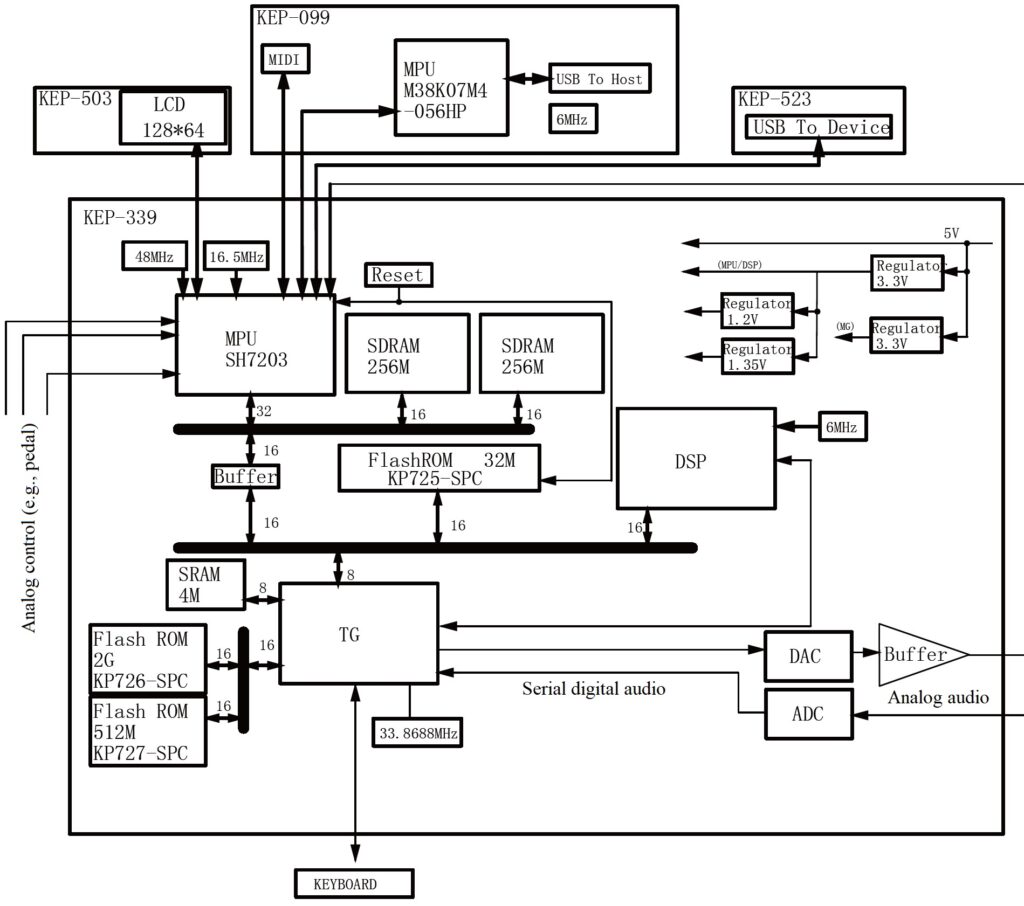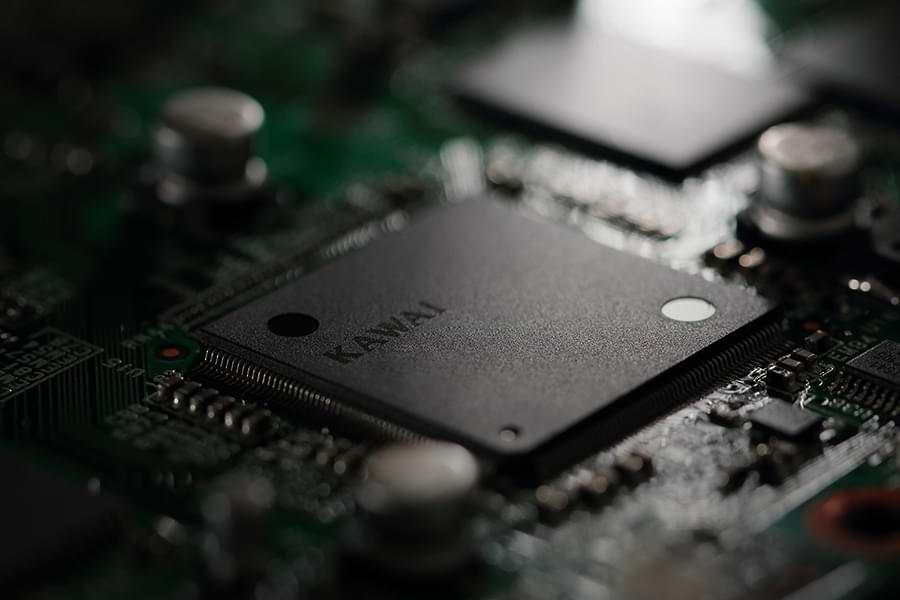Let’s take a brief look at the electronics inside the Kawai MP11 digital piano.
The Kawai MP11 is a pro-level 88-key stage piano with Grand Feel wooden key action and triple sensor detection. The MP11 has 40 voices total including Kawai concert and studio acoustic pianos, electric pianos and the usual motley crew of non-piano voices. Acoustic pianos are enhanced by Kawai’s Harmonic Imaging™ XL technology. 23 different kinds of effect can be applied. Electric piano gets special treatment with five amp simulators: Suitcase, Marshall stack, Jazz Chorus, Bassman and Leslie. The MP11 Virtual Technician allows control of tonal character, stereo width, string resonance, etc.
The MP11 has pitch bend and mod wheels, key set-ups (zones), assignable knobs, and many other features that make it suitable as a controller. It also has sought-after features like built-in power supply (no wall wart), 5-pin MIDI, XLR audio OUT.
That’s one respectable stage piano!
Having crawled through many service manuals before, the internals are not too surprising. There is one main digital electronics board surrounded by several peripheral boards for the LCD (128×64), USB interface, front panel gizmos, audio amplification, and various external connections. There are separate boards for handling AC main power.

I’m most interested in the on-board compute and, thus, I will focus on the main logic board. Like other high-end digital synthesis products (e.g., Yamaha Montage), there are multiple hardware processors. The MP11 has three main processors:
- Main CPU (MPU): Renesas SH7203
- Tone Generator (TG): unspecified by the service manual
- Effects (DSP): unspecified
Unfortunately, the Kawai service manual does not provide a detailed schematic or electrical parts list. Thus, the TG and DSP type are unspecified by the service manual. The DAC and ADC are unspecified, too. A fourth processor, Renesas 8-bit MPU M38K07M4, handles USB to HOST duties.
The MPU is the well-known Renesas SH7203, a 32-bit microcontroller incorporating an SH2A FPU RISC core. There are two external clocks: 48MHz and 16.5MHz. The 48MHz oscillator is probably the USB clock. The 16.5MHz clock is multiplied internally according to the software-configured frequency control register. The SH7203 can operate up to 200MHz internally.
The MPU has two 32 MByte SDRAMs (type unspecified), for 64 MBytes total. The MPU shares a 4 MByte flash ROM with the TG and DSP processors. Data moves in 16-bit words.
The tone generator, TG, has a 33.8688MHz external clock. The clock is an even multiple of 44.100kHz, the outgoing sample frequency. I suspect that the DAC and ADC employ the standard I2S serial communication protocol for digital audio. Thus, TG has 768 clock cycles to knock out a single N-bit sample to go to the DSP effect unit or the DAC.
Tear down videos such as the Kawai CN23 disassembly reveal Kawai proprietary tone generation integrated circuits (IC). The IC in the CN23, for example, is a massive, 208-pin beast!
TG has a small working SRAM (512MB, 8-bit data path, type unspecified). TG has two dedicated flash ROM devices (type unspecified) for TG program and waveform (sample) storage: 256 MBytes and 64 MBytes. Waveform data moves on 16-bit paths.
This MP11 repair video shows a large custom IC: Kawai K023-FP. There is another custom IC on the main logic board. Which one is sh7203? TG? DSP? It’s clear that Kawai design their own ICs.
The DSP unit has a relatively leisurely 6MHz clock. The DSP unit receives digital audio from the TG and returns it to TG, DSP does not have a direct connection to the DAC.
The MP11 has a LINE IN for external audio. The LINE IN is buffered and then converted to digital audio by the ADC (type unspecified). The digital audio stream goes to TG where it is mixed digitally with synthesized audio.
Armed with other tear down videos and resources on the Web, I’ll try to identify these unspecified MP11 components.
- Main CPU: Renesas 72030W200FP (package QFN-240, 240 pins)
- MPU SDRAM: Elite Semiconductor Memory Technology ESMT M12L25616A-6T 256Mbit SDRAM organized as 16M x 16-bit words
- TG: Kawai K023-FP identified in another Kawai service manual as “Sound Source/Touch LSI”
- Flash ROM: Generic NOR flash organized as N x 16-bit words (e.g., Spansion S29GL01GP12TFI020); Flash ROM ICs have Kawai labels identifying pre-loaded content
- TG SDRAM: Infineon CY7C1049DV33 4Mbit fast async SRAM organized as 512K x 8-bit bytes
- DSP: Texas Instruments TMS320VC5507 Fixed-point Digital Signal Processor
As to DAC, Kawai have used the Asahi Kasei AKM 4490EQ 32-bit DAC and Texas Instruments PCM1795 in previous products. I wonder how Kawai have coped while AKM recover from their factory fire? Perhaps they are using the ESS Technology ES9028Q2M 32-bit DAC instead?
If you see a photo of the Kawai KEP-339 main board, you are probably looking at the top side only. Please keep in mind that the bottom side is also populated. You will find the TI TMS320 DSP on the bottom side.
Folks are always surprised by the modest compute resources in digital keyboards. They expect to see giga Hertz clock speeds, gobs of memory and solid state storage devices (SSD). Synth engines are so-called embedded systems, not desktop workstations or laptops. The digital electronics need to run cool without heavy heatsinks and fans. In order to achieve power/heat goals, clock rates are low and basic memory interfaces are employed instead of PC busses such as SATA.
Hope this short tour is informative!
Copyright © 2023 Paul J. Drongowski

